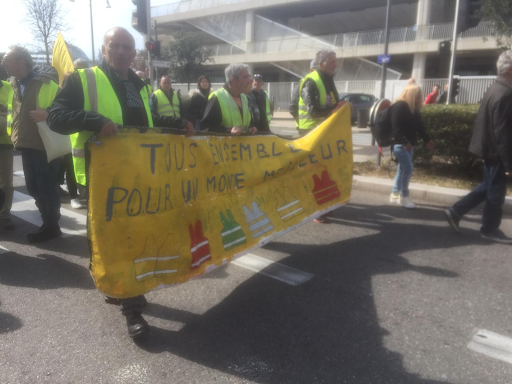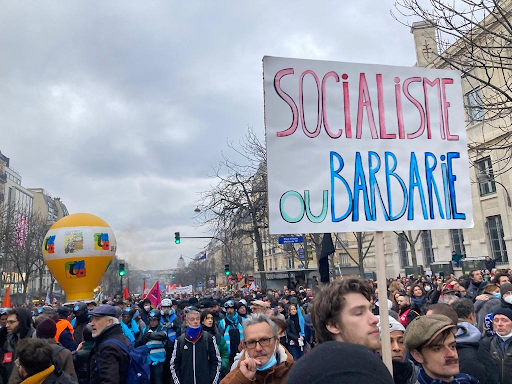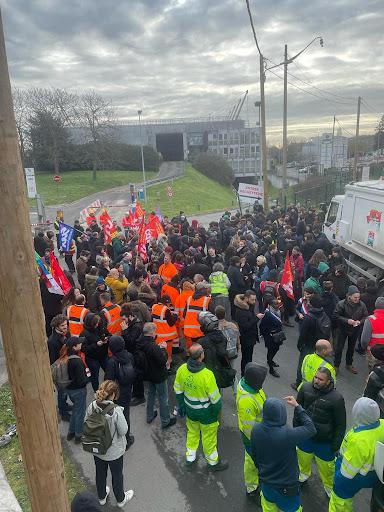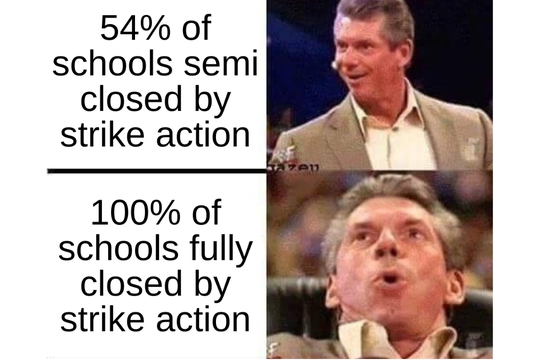The French Unions Strike Back

inquiry
The French Unions Strike Back
by
FX Hutteau
/
March 30, 2023
On the front lines of the struggle against Macron’s pension reform
Since January of this year, France has been living at the rhythm of Macron’s pension reform and of the powerful movement that opposes it. The safeguarding of the pension system is one of the recurrent battles of the trade unions and the French left against the neoliberals. It is enough to list the reforms to understand how recurrent this social conflict is: 1993, 1995, 2003, 2010, 2013 and the failed reform of 2019 beaten by the strike. The movement against this reform is a very broad movement: 93% of workers are opposed to the reform, a very broad trade union coalition make its base, and it has been supported by the recent union of the left (NUPES) in parliament. However, as a result of not winning anything after two months of very structured mobilisation, the movement has hardened.
To understand the current movement against the pension reform in France, it is necessary to understand the ‘French-style social movement’ (mouvement social à la française), which has been the general framework of mobilisations for more than 20 years. The archetype is the 1995 movement against the Juppé plan (a policy aimed at reducing the social rights of the public sector workers, and in particular pension rights.) The French-style social movement is an alliance between different economic sectors and different trade unions against neo-liberal reforms, so it is always a counter-attack. The French-style social movement has experienced a double crisis, which first emerged during the 2016 protests against the labour laws (loi travail) but also with the Gilets Jaunes movement, which many interpreted as the definitive end of this form of mobilisation. This movement is a litmus test for this form of mobilisation: is it still capable of winning social rights, wage increases and defending social security, or is it the swan song of the French-style social movement?
Firstly, 2016 was a moment of radicalisation of slogans and tactics. It was the first social movement to take place within the political framework of Macronism, as at the time Macron was still Minister of the Economy. This movement was against a new law, the ‘Ioi travaiI’, that was aimed at restricting labour rights and was, consequently, of vital interest to the trade unions, since it severely restricted their ability to organise and negotiate. However, the trade unions did not push their struggle beyond the extremely ritualised forms of social conflict that one has come to expect in France, such as the Tuesday or Thursday demonstration and strikes in the form of the ‘pearled strike’ (‘grève perlée’) i.e. without continuity on strike days.1 One of the issues at stake in the days to come is whether or not the union leaders will be able to effectively bring about a continuous strike.
The second challenge to the French-style social movement was provoked by the Gilets Jaunes. The Gilets Jaunes began in 2018 as an anti-tax movement with the rejection of the fuel price increase caused by a tax on CO2 emission. It should be noted that this demand fundamentally asked the question that bourgeois ecology refuses to answer, namely who pays for the increase in carbon emissions within the framework of the carbon markets established by the Kyoto Convention. The Gilets Jaunes movement attracted only a limited number of trade unionists. However, there has been a significant amount of support from the grassroots unions invested in the social movement of 2018. This brought together Gilets Jaunes and trade unionists turned Gilets Jaunes, from sectors that are still among the most combative.
The Gilets Jaunes also extended the territory of the struggle, from the big cities to the suburbs, the medium-sized cities and rural areas, which in many cases are much less densely populated in France. The classic form of action of the Gilets Jaunes was carried out on the roundabouts that can be found everywhere in the French suburbs and which are a symbol of the small cement entrepreneurs’ control over the territory. We see in the spatial composition of the current movement against pension reform continuities with the Gilets Jaunes who transformed places like roundabouts into centres of social conflict. It is not a coincidence that this time around, many of the actions organised by the unions have taken place on roundabouts.

Gilets Jaunes at the trade union demonstration in Marseille, March the 7th (image by Élodie Chédikian)
The Gilets Jaunes movement then experienced a transformation at the end of 2019 when Macron announced a reform to pensions. In many ways, this reform was worse than one currently proposed as it aimed at moving toward a marketised system thereby dismantling the system currently based on social solidarity. In fact, pension funds in France have been managed by workers since 1944 and the liberation of France from Nazi rule and are based on the principle of solidarity. This very powerful movement marked a first step in the Gilet Jaun-isation of the strike, of which three distinguishing characteristics can be highlighted: a strong opposition toward the government, the proliferation of local initiatives, and a consensus that the use of blockade strikes would be the only tactic that could guarantee victory. In a certain sense, this strategic diagnosis turned out to be correct, since it is one of the only movements to have won something in recent years. Today, the radicalization of the government on its positions makes clear, even for the most moderate unions, that only this method is effective in the context of Macronism. It must be said that the movement has shown exceptional levels of militancy, especially in the many workers’ and neighbourhood assemblies, and an intense degree of political activity characterised by mass participation.
In 2019, the presence of climate activists was crucial. We were coming out of a phase in which XR and some of the more radical and openly anti-capitalist currents (queer collectives, etc) were organising with Gilets Jaunes. We were coming out of a moment of international actions by XR that had managed to federate but nonetheless failed to build an offensive social force on climate issues. Some ecologist comrades had intervened on this occasion with a text that began: ‘The strike against the pension reform does not correspond to what we call an environmental struggle. However, we ecologists are on the picket lines, we support the mobilisations of the railway workers, the Gilets Jaunes, the teachers, the health workers and all those fighting against the reform. Why do ecologists support the strike?’ The main argument of this text was that the reduction of working hours is an ecological imperative, since any increase in overall working hours necessarily means an increase in the amount of biophysical resources extracted and an increase in the amount of CO2 emitted. This convergence and discourse is now found in many more parts of the current political ecology, which is undeniably a victory for the vanguard of the 2019 movement.

‘Socialism or Barbarie’ sign in front of the Paris demonstration, March the 7th (image by Francesco Brancaccio)
Apart from the specific framework of the 2019 movement in the wake of the Gilets Jaunes, the pension movements in France have a rather inter-classist nature, given the history of trade union demands, particularly among managers (cadres). The current movement is lead by the broadest possible coalition of unions within what is called an Intersyndicale.2 The defence of pensions has been a part of the demands of the French cadres movement since the 1930s: this gave a rather surprising spectacle in recent weeks of the remnants of the ‘cortêge de tête’ (equivalent to the black bloc in the anglophone world) marching right in front of the CFE-CGC, the general confederation of managers. It is therefore this interclass nature that explains both the immense popularity of this movement and the difficulty it has faced, until recently, in consolidating its antagonism.
It is therefore important to understand that this is no longer 2016, when the question was: how to radicalise of a workers’ movement that was struggling to exercise its power. The current movement is an inter-classist movement as evidenced by the ability of the centrist trade unions such as the CFDT to mobilise people for their demonstrations. This is in stark contrast to the 2019 movement, where the trade union rallies were typically lacklustre while the lead bloc in front of the union rally was far more radical and densely populated.
March the 7th was one of those days of intense militant activity in pickets and blockades: schools, high schools, bus and train stations in the Paris region were shut down by demonstrators. There is a very important political stake to be drawn from this situation, which the energy federations have understood very well: it is necessary to split the bourgeoisie on the pension issue. Since it is in fact already fractured, it is now a question of putting a lever in this opening. This fracture seemed obvious a year ago, since the MEDEF (the French employers confederation) had asked Macron not to make his reform. But CGT Energie realised that tax credits and tax exemptions are not enough from the point of view of capitalists for them to agree to be on Macron’s side at all costs. That is why the actions of cutting electricity in Amazon’s warehouses and various strategic places are particularly interesting: apparently tax credits alone do not make it possible to run a factory.

Gaz and Railway workers blocking the Gare de Lyon Train station in Paris (March the 23th) (Image by Ulysse Jacquin)
The reform
After repeating for months that the legal age for a full pension would be raised to 65 in 2031, the government is finally proposing an increase to 64. Macron made this reform one of the themes of his re-election last year. Indeed, the legal age will be raised to 64, at the rate of a quarter more per year, starting in September 2023 for the generation born in 1961. In reality, the reform is an extension of the Touraine reform voted under Hollande, with the difference that it accelerates the speed of this reform: in fact, instead of reaching the age of 43 for a full pension in 2035, with this reform we get there in 2027. Above all, therefore, this reform is an extension of the working hours performed across a lifetime. It is also a conflict of interpretation around the French social constitution. On the left, the interpretation is that the social security system is owned by the workers and should be governed by them, while the right has interpreted after the 1950s that these funds should be managed by the State or by capital.
However, the battle over this reform is also about working conditions in general, mainly the issue of occupational safety and health risks (penibilité). Macron said a few years ago that he does not like the word pénibilité. The issue is a real problem of recognition as the reform will abolish the recognition of occupational risks such as carrying heavy loads or exposure to mechanical vibrations. This pension reform is thus based on the idea that hard work does not exist. Macronist Senator Patriat explained on TV that hard work no longer exists by mobilising a futuristic fantasy according to which construction workers and movers in France would be equipped with exoskeletons. This reform demonstrates the Macronist bourgeoisie’s open hatred of workers. For example, a spokeswoman of Macron’s party, mocked Mouloud Sahraoui, a logistics worker at Geodis and one of the leaders of the very advanced and often victorious struggles in logistics, because he was demanding the right to full retirement at 50, when NUPES demands 60 instead of the current 62.

‘End of Work, Magical Life” sign at a demonstration in Paris (Image by Federico Puletti)
But this year’s pension reform is quite different from the one presented by Macron just before the pandemic, at the end of 2019. It was a structural reform that would not only lengthen the span of a working life, but also transform the pension system into a points-based system. This structural change was obviously preparing the transition to a marketised pension system. A powerful movement in 2019 had put the government in trouble, with important strikes and a social movement led by the Gilets Jaunes combining to create a political environment in which the Macronist pension reform stalled.
In response, the government moderated its reform in early 2020. However, the pandemic completely blocked further progress, with resistance emerging from both capital and labour. MEDEF, the bosses’ union, opposed pension reform precisely because it was considered too polarising after the lockdown and because capital was still being massively subsidised by state pandemic measures. It was this opposition that led the government to change their approach from a systemic transformation to a more gradual reform. The current measures propose a change to a specific parameter of the system, namely the legal retirement age, but not the system itself. Of course, this change will lead more and more people to invest in private supplementary pensions since they will no longer be able to retire in good health with the public social security system while receiving a decent pension. However, Macron’s shift to a parametric reform is a symptom of the difficulty of the French neoliberal bloc to propose a social project in the wake of the COVID pandemic. The strength of labour is blocking a complete neoliberal solution to the pension problem.
The current reform is essentially the same type as the 2010 reform. However, in that reform the workers’ management approach was complimented by a series of organisations that aim to integrate social security management into the neo-liberal perspective of budgetary balance. It differs considerably from the 2019 one, marking a lack of a real political initiative on the part of Macron, his project being limited to the European budgetary stability rule.
Governments since 2010 have repeatedly invoked a budgetary imbalance to justify pension reform after the COR (Conseil d’orientation des retraites) declared that the current state of affairs was unsustainable.3 In fact, the pensions of current pensioners are paid by current workers. This poses the following problem for the bourgeoisie: how to maintain the level of pensions when the ratio of the current population to pensioners is decreasing. Indeed, it is worth noting that this shift in the workers-pensioners ratio fully reflects the gains in productivity: whilst the ratio of pensioners to workers has tripled, so has the productivity of labour.4 It should also be mentioned that in recent years the COR has almost always been wrong in the reports motivating previous pension reforms. In fact, the French bourgeoisie persists in its attempt to liquidate the public social security, however it does not have the political capacity this time, especially after the failure of the 2019 reform, to liquidate it openly. In this context the parametric reform is a way for the Macronists to let public pensions wither away passively while private pension plans grow.
This time the COR report proposes four scenarios, only one of which is unbalanced. This is why the political left denounces the reform as a scam. In fact, the reform does nothing to balance the social security accounts, rather it aims at a transition towards a private pension system. The French welfare system is once again under attack from the capitalists. The aims of this reform are to increase working hours in order to increase growth rates and also create new markets for insurance companies.
From a Social Crisis to a Political One
The factor that shifted the current movement against the pension reform from a social crisis to a broader political crisis was the government’s decision to use article 49.3 of the French constitution. This article allows the government to pass a law without the parliament voting on it. The only way to block the law from passing is then a vote of a motion of no confidence, that if passed brings the government down. Since 2016, this article of the constitution has become a symbol of neoliberal authoritarianism. The announcement of the use of this article on March the 16th sparked demonstrations everywhere in France. In Paris, the movement started to gather in front of the Assemblée Nationale on Place de la Concorde at night to protest the authoritarian methods of the Macronist regime. Efforts at parliamentary resistance failed, with a motion of no confidence proposed by a centrist independent MP falling 9 votes short of bringing down the government. Thus the counter-attack could only come from the most militant workers’ sectors such as the railway workers or the refuse collectors.
The failure of this motion of censure made clear that negotiation through parliamentary means was blocked, and at the same time the call from the Intersyndicale to negotiate with the government was at a dead end. It should be noted that it is the Macronists themselves who burned all the bridges that might have deescalated this social conflict. The result has been actions across France against the offices of the MPs in favour of the reform all around France. The CGT, for instance, started, to organise the building of brick walls in front of some MPs’ offices or against the local offices of the MEDEF.

A (cemented !) wall built by the CGT in Albertville, Savoie in front of a right-wing MP’s office who did not vote for the motion of no confidence. The poster on the right reads ‘Traitor of the people !’
The corollary of this acute political crisis is the systematic use of police brutality to prevent spontaneous demonstrations from happening. After the motion of censure failed, on March 20th, the gatherings near the Assemblée Nationale were all kettled, and various acts of police brutality were committed. The state’s strategy of repression made us adopt a more versatile strategy based on the proliferation of places of demonstrations. The gatherings started on the Place de la Concorde in front of the National Assembly. These rallies were an opportunity for the youth to take part in the movement in which they had not been so active until now. These moments of gathering were thuring two evenings of meeting places, until the police locked the place. Since then, groups of young people are organising themselves mainly on encrypted messengers like Telegram or Signal to run meeting points. These riotous demonstrations are however very spontaneous and disorganised, the groups of demonstrators recognizing each other by chants such as ‘Tout le monde déteste la police’. For example, last Thursday nearly 400 garbage fires were set in Paris after the demonstration. These spontaneous movements of the youth are not limited to Paris; there were also some in smaller cities, even if this mode of organisation remains urban. In response to police brutality, the youth have entered the movement in ever greater numbers and even more high schools have been barricaded (200 this Monday which was not a day of mobilisation).
But the recent qualitative jump in the movement is deeply related to some very advanced workers in the energy, transport and waste sectors. The favoured tactic of these sectors, whichhave been on strike since March the 7th is the blockade. In the case of the waste sector in Paris, the strike was constructed after an in-depth study of the logistic chain of waste in Paris allowing strikes at choke points such as the incineration plant at Ivry. The idea is that blockades of strategic points in the logistical chain make work virtually impossible at another point in the circuit; for instance, by making it impossible to unload garbage trucks at the end of the day. By doing so, it is possible to make the time to hold meetings with the workers that are not on strike yet and discuss unionisation, working conditions, and pensions. These blockades and strikes are the conditions of possibility for the savage demonstrations happening in Paris at night as it means the rubbish remains uncollected, and that same rubbish is what ends up being used as fuel on the barricades.

A blockade with the refuse collectors in Romainville (image by CGT éduc’action 93/Twitter)
In this context, the main obstacle to the movement are state-imposed limits on the right to strike. Since Sarkozy’s presidency, it is possible for the state to use the police to force workers on strike to go back to work if their action blocks some strategic assets, such as tactical fuel supplies. Obviously, these requisitions are used in a distorted way for instance, to force the refuelling of the Paris airports. The mobilisation of the workers and the students against these requisitions is crucial for the continuity of the movement, for the preservation of the right to strike and for collective self-defence against unlimited police powers.
On Thursday March 23rd the movement took another step towards the generalisation of the strike as the movement grew again with 3,5 million people on the street and good numbers participating in strikes in various sectors. This day was characterised by a proliferation of actions such as the blockade of the Charles-De-Gaulle Airport of Paris organised by the local section of the CGT-Roissy involving many airport workers. The demonstration in Paris also saw a surge in physical conflict marking the end of what began as a very calm movement. This 9th day of national strike is very representative of the rhythm of these mobilizations: blockades and actions in the morning, demonstrations in the afternoon and savage demonstrations in the evening including one organised by local trade-unions from the Paris region.
More than ever, this movement attests to the efficacy of the strike as a mode of action, against all claims to its obsolescence. Of course, it is no longer simply about the strike in the big factory, since the strike, the riot and the blockade do not correspond so much to a phase of capitalism as to a way of knowing and acting on production and reproduction. If the outcome of the conflict remains uncertain, the long-term challenge of the conflict is to see if a new generation of rank-and-file trade unionists is able to emerge from this movement, and the massive involvement of youth in the last few days seems to be heading in this direction.
-
The term is ambiguous even in French, originally it designates a mode of rotation of the strike which sabotages the continuous functioning of the work process while allowing workers’ to reduce their lost wages. This mode of action is illegal in France. Nowadays, the “grève perlée” designates discontinuous strike days, a practice favoured by moderate unions. Opponents of this practice call it ‘leapfrogging’. ↩
-
This coalition includes CGT (Confédération générale du travail), SUD-Solidaires, Force Ouvrière, CFDT, FSU (Fédération syndicale unitaire), CFDT (Confédération Française Démocratique des travailleurs), CFE-CGC (Confédération Française de l’Encadrement - Confédération générale des cadres) and CFTC (Confédération des travailleurs chrétiens). ↩
-
The Conseil d’orientation des retraites is a budget steering committee dedicated to public mandatory pension funds. It is composed of MPs, trade union and employer representatives. ↩
-
Since 1979, work productivity has tripled in France. https://www.strategie.gouv.fr/sites/strategie.gouv.fr/files/atoms/files/fs-2020-dt-productivite-travail-decembre.pdf ↩
author
FX Hutteau
Subscribe to Notes from Below
Subscribe now to Notes from Below, and get our print issues sent to your front door three times a year. For every subscriber, we’re also able to print a load of free copies to hand out in workplaces, neighbourhoods, prisons and picket lines. Can you subscribe now and support us in spreading Marxist ideas in the workplace?
Read next

Marked Absent! - 15th March Strike
by
Marked Absent
/
March 13, 2023

